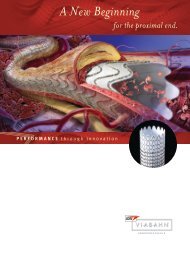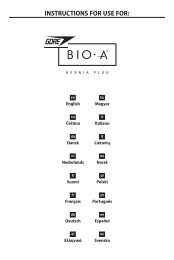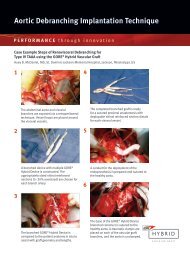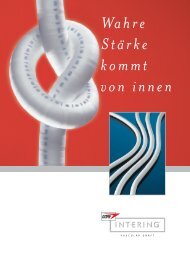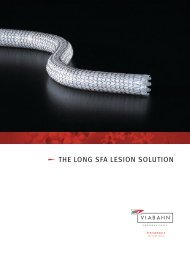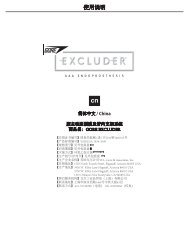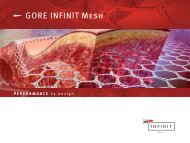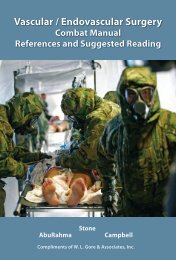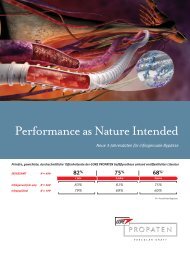Printable PDF Version - Gore Medical
Printable PDF Version - Gore Medical
Printable PDF Version - Gore Medical
Create successful ePaper yourself
Turn your PDF publications into a flip-book with our unique Google optimized e-Paper software.
G O R E P E R I P H E R A L<br />
V I S I O N<br />
P E R F O R M A N C E t h r o u g h c o l l a b o r a t i o n<br />
45 mm GORE ® TAG ® Thoracic EndOPROsTHEsis<br />
Now AvAILAble IN THE US<br />
Expanding Thoracic Aortic Treatment Range up to 42 mm with FDA<br />
Approval of 45 mm GORE ® TAG ® Device<br />
W. L. <strong>Gore</strong> & Associates (<strong>Gore</strong>) received approval from the US Food and Drug<br />
Administration (FDA) to market a 45 mm diameter version of the GORE ®<br />
TAG ® Thoracic Endoprosthesis for treatment of aneurysms of the descending<br />
thoracic aorta. The larger diameter device allows treatment of thoracic aortic<br />
aneurysms with proximal and distal neck diameters ranging from 37 – 42 mm<br />
and is now available for commercial use in the US.<br />
“The availability of the 45 mm GORE ® TAG ® Device will provide physicians<br />
treating thoracic aneurysms with more options,” explained Dr. Michel<br />
Makaroun, Chief of the Division of Vascular Surgery and Professor of Surgery<br />
at the University of Pittsburgh <strong>Medical</strong> Center (UPMC). Dr. Makaroun acted<br />
as the National Principal Investigator for the 45 mm GORE ® TAG ® Device<br />
clinical study.<br />
The 45 mm GORE ® TAG ® Device is available in 10, 15 and 20 cm lengths. In<br />
addition, all GORE ® TAG ® Devices, including the 45 mm device are delivered<br />
on a modified delivery catheter that is designed for enhanced trackability<br />
and deliverability. The modified GORE ® TAG ® Device delivery catheter is a<br />
simple, single-step deployment system engineered to optimize placement<br />
and control. The novel sheathless delivery catheter provides flexibility for<br />
navigating tortuous anatomy and low deployment forces.<br />
IN THIS ISSUE<br />
45 mm GORE ® TAG ® Thoracic Endoprosthesis Now Available in the US . . . . . . . . . . . 1 – 2<br />
Revolutionary GORE ® DrySeal Sheath Now Available . . . . . . . . . . . . . . . . . . . . . . . 2<br />
Q50 Stent Graft Balloon Catheter Launches in US . . . . . . . . . . . . . . . . . . . . . . . . . 3<br />
GORE ® VIABAHN ® Endoprosthesis Receives New Approvals Abroad . . . . . . . . . . . . . . . 3<br />
Case Study: Treatment of an Iliac Chronic Total Occlusion . . . . . . . . . . . . . . . . . . 4 – 5<br />
Highlights of the Medicare Final Physician CY2010 and the Proposed IPPS FFY2011 Rules . . 6<br />
Introducing the GORE ® PROPATEN ® Vascular Graft Configured for Pediatric Shunt . . . . . . . 7<br />
2010 Events. . . . . . . . . . . . . . . . . . . . . . . . . . . . . . . . . . . . . . . . . . . . . . 7<br />
Literature Recommendations . . . . . . . . . . . . . . . . . . . . . . . . . . . . . . . . . . . . 8<br />
Continued on page 2<br />
N o 0 0 6 • J U N E 2 0 1 0
I N T H E N E W S<br />
Continued from front page<br />
45 mm GORE ® TAG ® Device....<br />
The GORE ® TAG ® Device was first approved<br />
by the FDA in March 2005. With more<br />
than 40,000 devices sold worldwide, the<br />
GORE ® TAG ® Device is a leading option<br />
for the less invasive treatment of TAA.<br />
The GORE ® TAG ® Device is also the only<br />
endovascular thoracic device with more<br />
than ten years of worldwide commercial<br />
data. Five year follow-up data from the<br />
clinical study indicates that subjects<br />
treated with the GORE ® TAG ® Device have<br />
improved aneurysm-related survival and<br />
a consistently lower incidence of major<br />
adverse events compared to subjects<br />
treated with open surgical repair.<br />
Clinical studies are currently under way in<br />
the US to evaluate the safety and efficacy<br />
of the next generation Conformable<br />
GORE ® TAG ® Device in three primary<br />
etiologies: aneurysms of the descending<br />
thoracic aorta (DTA), traumatic aortic<br />
transection of the DTA, and acute<br />
complicated type B dissection.<br />
revolutionary GORE ® DRYSEAL<br />
SHEATH NOW AVAILABLE<br />
The first use of the revolutionary GORE ® DrySeal<br />
Sheath occurred at The Methodist Hospital<br />
(TMH) in Houston, Texas on April 30, 2010. The<br />
hemostatic GORE ® DrySeal Valve is unique in two<br />
important ways — it is pressurized to create a seal,<br />
minimizing blood loss, and this unique seal has<br />
the ability to accommodate multiple wires and<br />
catheters simultaneously.<br />
The first case was performed during a <strong>Gore</strong>sponsored<br />
Acute Symptomatic AAA Workshop<br />
held in The Methodist DeBakey Heart and Vascular<br />
Center in Houston. The procedure was conducted<br />
by Alan Lumsden, MD, chairman of the Department<br />
of Cardiovascular Surgery. “The ability of the GORE ®<br />
DrySeal Valve to accommodate multiple devices<br />
during difficult procedures with minimal blood loss<br />
keeps the operating field free from excess blood,<br />
while helping to prevent unnecessary blood loss to<br />
the patient,” Dr. Lumsden said. “The GORE ® DrySeal<br />
Sheath requires no intra-procedural manipulation<br />
of the valve, delivering consistent performance<br />
throughout the procedure and allowing the<br />
physician to maintain focus on the endovascular<br />
procedure — without being concerned about blood<br />
loss at the patient access site.”<br />
<strong>Gore</strong> recently received FDA clearance to market the<br />
GORE ® DrySeal Sheath, which is comprised of the<br />
GORE ® DrySeal Valve attached to the introducer<br />
sheath, a dilator and a 2.5 ml valve inflation<br />
syringe. The valve consists of a silicone outer tube<br />
and an inner film tube that create an effective<br />
hemostatic seal that easily adapts to the profiles<br />
of the inserted devices. The device is available in<br />
profiles from 12 to 26 Fr, in 2 Fr increments, and<br />
has a working length of 28 cm.<br />
PERIPHERAL VISION • N o 006 • JUNE 2010 • 2
Q50 Stent Graft bALLOOn cATHETER<br />
LAUnches in US<br />
Another addition to the <strong>Gore</strong> Endovascular<br />
Portfolio is the Q50 Stent Graft Balloon Catheter,<br />
which became broadly available in the US earlier<br />
this month. Designed for use with aortic stent<br />
grafts that treat abdominal aortic aneurysms<br />
(AAA), this balloon catheter is ideal for use with<br />
the flexibility of the GORE ® EXCLUDER ® AAA<br />
Endoprosthesis in challenging anatomies.<br />
The Q50 device is a full occlusion / modeling<br />
balloon catheter that is uniquely conformable to<br />
help aortic stent grafts fully expand and seal in<br />
both tortuous and straightforward vessels ranging<br />
from 10 – 50 mm in diameter. No other single<br />
stent graft balloon features this broad range of<br />
inflation diameters. With its 8 Fr diameter and<br />
65 cm length, the catheter is ideal for abdominal<br />
aneurysm procedures and contributes to enhanced<br />
operator control, ease-of-use and patient safety.<br />
The short, flexible tip increases trackability<br />
through challenging anatomy, and a compliant<br />
conformable polyurethane balloon inflates and<br />
deflates rapidly to give physicians more control.<br />
The Q50 Stent Graft Balloon Catheter is compatible<br />
with standard 0.035" guidewires and low-profile<br />
12 Fr introducer sheaths.<br />
“I am pleased with the tracking of the Q50<br />
Balloon and with the more convenient, shorter<br />
catheter length during a procedure with a GORE ®<br />
EXCLUDER ® Device,” said Jason Dew, MD. “I believe<br />
that it has much better tactile feel during inflation<br />
and it is convenient that one balloon can be used<br />
with a broader range of stent graft diameters,<br />
helping us to minimize inventory challenges for the<br />
hospital,” said Andrew Hearn, MD, both of Carolina<br />
Vascular and Vein in Burlington, North Carolina.<br />
<strong>Gore</strong> is the exclusive US distributor of the Q50 Stent<br />
Graft Balloon Catheter for QXMédical, a medical<br />
device company based in Montreal, Canada<br />
specializing in the design, development and<br />
manufacturing of state-of-the-art medical devices.<br />
The US Food and Drug Administration (FDA) cleared<br />
the catheter for marketing in October 2009.<br />
GORE ® Viabahn ® Endoprosthesis<br />
Receives New Approvals AbROAd<br />
GORE ® VIABAHN ® Endoprosthesis with Heparin<br />
Bioactive Surface* was recently approved for<br />
distribution in Australia and is marketed under<br />
the tradename GORE ® VIABAHN ® Endoprosthesis<br />
with PROPATEN Bioactive Surface. The GORE ®<br />
VIABAHN ® Endoprosthesis has been available in<br />
Australia for ten years, but now we will be able to<br />
offer these customers a further innovation to the<br />
product, with the Heparin Bioactive Surface.<br />
Other recent GORE ® VIABAHN ® Endoprosthesis<br />
approvals include Brazil, Thailand and South<br />
Korea. “As a global organization, we are diligent<br />
in our efforts to make this innovative product line<br />
available to interventionalists and PAD patients<br />
around the world.” said Chris Tieché, PhD, <strong>Gore</strong><br />
Product Specialist.<br />
* The GORE ® Viabahn ® Endoprosthesis with Heparin Bioactive<br />
Surface may be sold under different tradenames in different<br />
markets.<br />
PERIPHERAL VISION • N o 006 • JUNE 2010 • 3
C A S E S T U D Y<br />
treatment of an iliac chronic TOTAL occLUsion<br />
Barry S. Weinstock, MD<br />
Orlando Regional <strong>Medical</strong> Center, Orlando, Florida<br />
Clinical Challenge<br />
The patient is a 77-year-old woman evaluated for right buttock claudication.<br />
She has past medical history notable for spine surgery, severe hypertension<br />
with left ventricular hypertrophy, and hyperlipidemia. She also has a history<br />
of smoking. Current medications include lisinopril, olmesartan, aliskiren,<br />
metoprolol, aspirin, and fish oil. Lower extremity Doppler exam revealed<br />
reduced ankle-brachial index (ABI) of 0.55 in the right lower extremity and<br />
0.70 in the left lower extremity. CT angiogram showed flush ostial chronic<br />
total occlusion of the right common iliac artery with reconstitution of the<br />
proximal common femoral artery. There was 50% stenosis of the left common<br />
iliac artery and no femoro-popliteal disease or significant trifurcation vessel<br />
disease. The occlusion was not felt to be well-suited to percutaneous<br />
revascularization but the patient declined surgical revascularization.<br />
Procedure<br />
The patient underwent angiography via a left common femoral approach.<br />
This confirmed flush ostial total occlusion of the right common iliac artery<br />
with reconstitution of the proximal right common femoral artery (Figures<br />
1, 2). Access was planned for the proximal right superficial femoral artery<br />
but a short 6 cm, 7 Fr sheath was inadvertently placed in the proximal<br />
profunda femoris. The sheath was exchanged for a 11 cm, 7 Fr sheath and<br />
the iliac occlusion was crossed retrograde but subintimally using a 90 cm<br />
Spectranetics QUICKCROSS ® Catheter and a 0.035" Terumo GLIDEWIRE ®<br />
Guidewire. A Cordis OUTBACK ® LTD ® Catheter was used to advance a 0.014"<br />
Figure 1 Figure 2<br />
Abbott ASAHI Grand Slam Guidewire into the aorta with re-entry at the aortoiliac<br />
bifurcation.<br />
The entire iliac artery was dilated with 5 x 100 mm and 7 x 100 mm<br />
angioplasty balloons (Figure 3). The ostial right iliac artery was stented with<br />
a 7 x 59 mm Atrium iCAST Balloon Expandable Covered Stent. The remainder<br />
of the common iliac artery and the entire external iliac artery were stented<br />
with a single 7 x 150 mm GORE ® VIABAHN ® Endoprosthesis with Heparin<br />
Bioactive Surface which extended to the site of reconstitution in the proximal<br />
common femoral artery. Post-dilatation of both stent-grafts was performed<br />
with a 7 x 100 mm angioplasty balloon.<br />
PERIPHERAL VISION • N o 006 • JUNE 2010 • 4
Figure 3 Figure 4 Figure 5<br />
Results<br />
Completion angiography reveals a widely patent right iliac artery with brisk<br />
flow and no residual stenosis (Figures 4, 5). Although the right hypogastric<br />
artery remains occluded, the left hypogastric artery is patent. At clinical<br />
follow-up, the patient was asymptomatic with no claudication. A follow-up<br />
Doppler exam revealed improvement in her right leg ABI from 0.55 to 1.0.<br />
is higher than desired. The flexibility of the GORE ® VIABAHN ® Endoprosthesis<br />
is also well-suited to the non-linear course of the external iliac artery. Overall,<br />
percutaneous treatment of iliac occlusions with the GORE ® VIABAHN ®<br />
Endoprosthesis is an excellent alternative to surgical revascularization.<br />
Physician Comments<br />
The use of the GORE ® VIABAHN ® Endoprosthesis with Heparin Bioactive<br />
Surface is ideal for treatment of iliac total occlusions, particularly when the<br />
hypogastric artery is chronically occluded. Restenosis rates with bare metal<br />
stents, particularly when placed after subintimal crossing of iliac occlusions,<br />
PERIPHERAL VISION • N o 006 • JUNE 2010 • 5
R E I M B U R S E M E N T C O R N E R<br />
Highlights of the Medicare Final Physician CY2010 and the Proposed IPPS ffy2011 Rules<br />
Medicare CY2010 Final Rule for the Physicians Fee Schedule Payment Policies<br />
The Medicare CY 2010 final rule for Payment Policies paid under the Physicians Fee Schedule was effective on January 1, 2010. The final rule<br />
implemented two provisions that resulted in significant impact to physician payments.<br />
The first provision was the implementation of the new survey data that CMS incorporated into the PE (practice expense) component of the RVU (relative<br />
value unit) calculation for CY2010. This resulted in significant RVU shifts between certain CPT ® Codes. CMS maintains it is the most comprehensive PE<br />
source of data to date and therefore more accurate.<br />
The second significant provision was the conversion factor amount which is used to convert the RVUs to the Physicians Fee Schedule Payments.<br />
The methodology is mandated by Congress and termed the SGR (sustainable growth rate). The proposed CY2010 SGR amount was a decrease of 21.5%<br />
from the CY2009 SGR amount. Congress passed a bill in December 2009 that was effective from January 1, 2010 through February 28, 2010 that<br />
avoided the negative 21.5% by implementing a zero percent update. Congress passed a second law in March 2010 to extend this zero percent update<br />
from March 1, 2010 to March 31, 2010. In April 2010, Congress passed a third law to again extend this zero percent update from April 1, 2010 to May<br />
31, 2010. There are proposed bills in Congress to permanently revise the SGR calculation. Refer to the AMA and your specialty medical society websites<br />
for more information regarding this issue.<br />
Medicare ffy2011 Proposed Rule for the Hospital Inpatient Prospective Payment System (IPPS)<br />
The Medicare FFY 2011 Proposed Rule for the Hospital Inpatient Prospective Payment System (IPPS) was posted on April 19, 2010.<br />
CMS estimates that operating payments to all hospitals will be reduced in FFY2011 by 0.1 percent. This does not include any changes made by<br />
the Patient Protection and Affordable Care Act (PPACA). It does include a reduction to recover a portion of the excess payments due to coding and<br />
classification changes resulting from the transition to the MS-DRG methodology.<br />
CMS published proposed hospital inpatient Quality Measures for FFY 2011, 2012, 2013, and 2014 as well as possible future measures. For FFY 2013,<br />
CMS has proposed that hospitals be required to choose one of four topic areas to report the identified measures to a qualified registry. The four topic<br />
areas are: ICD Complications, Stroke, Nursing Sensitive Care, and Cardiac Surgery. The identified measures for each topic can be found in the proposed<br />
rule. CMS is proposing a self-nomination process to approve qualified registries which must be submitted by October 15, 2010. CMS lists the criteria for<br />
a qualified registry in the proposed rule.<br />
Public comments on the FFY2011 IPPS Proposed Rule may be submitted by June 18, 2010.<br />
This information is provided as a general update. Consult the CMS website for updates and details on these rules.<br />
Documentation Resource<br />
CMS Website: http://www.cms.hhs.gov<br />
<strong>Gore</strong> is available to answer your reimbursement questions.<br />
For more information, contact Coverage, Coding and Reimbursement Specialists at <strong>Gore</strong><br />
Email: Asheen@wlgore.com<br />
928.864.2420<br />
Toll free: 800.528.1866 Ext. 42420<br />
PERIPHERAL VISION • N o 006 • JUNE 2010 • 6
P R O D U C T U P D A T E S &<br />
2 0 1 0 E V E N T S<br />
INTRODUCING THE GORE ® PROPATEN ® VASCULAR GRAFT CONFIGURED FOR PEDIATRIC SHUNT<br />
<strong>Gore</strong> has introduced a new category in pediatric shunts with the addition of PROPATEN Bioactive Surface. Pediatric shunts are small<br />
diameter (3 – 6 mm) vascular connections between systemic and pulmonary circulations. The shunts provide additional blood flow<br />
to the lungs as a palliative procedure in patients with cyanotic congenital heart disease. Expanded PTFE (ePTFE) vascular grafts<br />
are routinely used as pediatric shunts due to their superior performance and ease of use compared to native vessels. With the<br />
improvement of surgical techniques and postoperative care, pediatric cardiac surgeons are palliating and repairing increasingly<br />
complex lesions. Complications associated with the surgical procedure and the use of prosthetic shunts in these complex defects<br />
are multivariate and have not been completely eliminated. These complications, including shunt thrombosis, are experienced by<br />
all pediatric cardiac surgeons throughout the world. Although the use of ePTFE shunts are not without complications, to date it is<br />
reported in the literature as the best surgical strategy available. The addition of PROPATEN Bioactive Surface to the GORE Pediatric<br />
Shunt is designed to minimize thrombosis.<br />
The GORE ® PROPATEN ® Vascular Graft Configured for Pediatric Shunt is an excellent addition to the product line.<br />
DATE NAME LOCATION<br />
GORE EVENTS<br />
June 17 – 18 Advanced AAA Symposium Morristown, New Jersey<br />
June 21 – 22 AAA Percutaneous Workshop Houston, Texas<br />
June 24 – 25 Endo and Surgical Technology Forum Flagstaff, Arizona<br />
June 28 – 29 AAA Foundation Skills Workshop Dallas, Texas<br />
July 15 – 16 Aortic Technology Forum Flagstaff, Arizona<br />
July 19 – 20 AAA Percutaneous Workshop Chicago, Illinois<br />
July 22 – 23 Acute Symptomatic AAA Workshop Albany, New York<br />
July 22 – 23 Advanced AAA Symposium Seattle, Washington<br />
August 26 – 27 Endo and Surgical Technology Forum Flagstaff, Arizona<br />
SUPPORTED CONGRESSES<br />
June 10 – 13 Society of Vascular Surgery Boston, Massachusetts<br />
September 11 – 15 European Association of Cardio-Thoracic Surgery Geneva, Switzerland<br />
September 16 – 19 European Society of Vascular Surgery Amsterdam, Netherlands<br />
September 21 – 25 Transcatheter Cardiovascular Therapeutics Washington, District of Columbia<br />
PERIPHERAL VISION • N o 006 • JUNE 2010 • 7
L I T E R A T U R E R E C O M M E N D A T I O N S<br />
AAA<br />
The United Kingdom EVAR Trial Investigators. Endovascular versus open<br />
repair of abdominal aortic aneurysm. New England Journal of Medicine<br />
2010;362(20):1863-1871.<br />
The United Kingdom EVAR Trial Investigators. Endovascular repair of aortic<br />
aneurysm in patients physically ineligible for open repair. New England<br />
Journal of Medicine 2010;362(20):1872-1880.<br />
Albertini JN, Favre JP, Bouziane Z, Haase C, Nourrissat G, Barral X. Aneurysmal<br />
extension to the iliac bifurcation increases the risk of complications and<br />
secondary procedures after endovascular repair of abdominal aortic<br />
aneurysms. Annals of Vascular Surgery. In press.<br />
Hoshina K, Kato M, Mikuriya A, Ohkubo N. Successful endovascular repair<br />
in two cases of graft limb occlusion after endovascular aneurysm repair for<br />
abdominal aortic aneurysms. Surgery Today 2010;40(5):487-490.<br />
Patterson BO, Holt PJ, Hinchliffe R, Nordon IM, Loftus IM, Thompson MM.<br />
Existing risk prediction methods for elective abdominal aortic aneurysm repair<br />
do not predict short-term outcome following endovascular repair. Journal of<br />
Vascular Surgery. In press.<br />
Hayes PD, Sadat U, Walsh SR, et al. Cost-effectiveness analysis of<br />
endovascular versus open surgical repair of acute abdominal aortic<br />
aneurysms based on worldwide experience. Journal of Endovascular Therapy<br />
2010;17(2):174-182.<br />
Kopp R, Zürn W, Weidenhagen R, Meimarakis G, Clevert DA. First experience<br />
using intraoperative contrast-enhanced ultrasound during endovascular<br />
aneurysm repair for infrarenal aortic aneurysms. Journal of Vascular Surgery<br />
2010;51(5):1103-1110.<br />
Have a story idea or case study to share?<br />
Send your suggestions to peripheralvision@wlgore.com<br />
Please visit goremedical.com to subscribe to an<br />
online version of <strong>Gore</strong> Peripheral Vision, or contact<br />
your local <strong>Gore</strong> Sales Associate to be added to the<br />
distribution list.<br />
W. L. <strong>Gore</strong> & Associates, Inc.<br />
Flagstaff, AZ 86004<br />
+65.67332882 (Asia Pacific)<br />
00800.6334.4673 (Europe)<br />
800.437.8181 (United States)<br />
928.779.2771 (United States)<br />
goremedical.com<br />
Prenner SB, Turnbull IC, Malik R, et al. Outcome of elective endovascular<br />
abdominal aortic aneurysm repair in octogenarians and nonagenarians.<br />
Journal of Vascular Surgery. In press.<br />
PERIPHERAL VASCULAR TREATMENT<br />
Pedersen G, Laxdal E, Ellensen V, Jonung T, Mattsson E. Improved patency and<br />
reduced intimal hyperplasia in PTFE grafts with luminal immobilized heparin<br />
compared with standard PTFE grafts at six months in a sheep model. Journal<br />
of Cardiovascular Surgery. In press.<br />
Pulli R, Dorigo W, Castelli P, et al; Propaten Italian Registry Group. Midterm<br />
results from a multicenter registry on the treatment of infrainguinal critial limb<br />
ischemia using a heparin-bonded ePTFE graft. Journal of Vascular Surgery<br />
2010;51(5):1167-1177.<br />
PERIPHERAL VISION • N o 006 • JUNE 2010 • 8<br />
INDICATIONS FOR USE IN THE US: The GORE TAG ® Thoracic Endoprosthesis is intended for endovascular repair of aneurysms of the descending<br />
thoracic aorta in patients who have appropriate anatomy, including: Adequate iliac / femoral access; Aortic inner diameter in the range of 23-<br />
42 mm; ≥ 2 cm non-aneurysmal aorta proximal and distal to the aneurysm. CONTRAINDICATIONS: Patients with known sensitivities or allergies<br />
to the device materials. Patients with a systemic infection who may be at risk of endovascular graft infection. Refer to Instructions for Use at<br />
goremedical.com for a complete description of all warnings, precautions and adverse events.<br />
INDICATIONS FOR USE: Trunk-Ipsilateral Leg Endoprosthesis and Contralateral Leg Endoprosthesis Components. The GORE EXCLUDER ®<br />
AAA Endoprosthesis is intended to exclude the aneurysm from the blood circulation in patients diagnosed with infrarenal abdominal aortic<br />
aneurysm (AAA) disease and who have appropriate anatomy as described below: Adequate iliac / femoral access; Infrarenal aortic neck<br />
treatment diameter range of 19 – 29 mm and a minimum aortic neck length of 15 mm; Proximal aortic neck angulation ≤ 60°; Iliac artery<br />
treatment diameter range of 8 – 18.5 mm and iliac distal vessel seal zone length of at least 10 mm. Aortic Extender Endoprosthesis and Iliac<br />
Extender Endoprosthesis Components. The Aortic and Iliac Extender Endoprostheses are intended to be used after deployment of the GORE<br />
EXCLUDER ® AAA Endoprosthesis. These extensions are intended to be used when additional length and / or sealing for aneurysmal exclusion<br />
is desired. CONTRAINDICATIONS: There are no known contraindications for these devices. Refer to Instructions for Use at goremedical.com for a<br />
complete description of all warnings, precautions and adverse events.<br />
INDICATIONS FOR USE in the us: The GORE VIABAHN ® Endoprosthesis is indicated for improving blood flow in patients with symptomatic<br />
peripheral arterial disease in superficial femoral artery lesions with reference vessel diameters ranging from 4.0 – 7.5 mm. The GORE VIABAHN ®<br />
Endoprosthesis is indicated for improving blood flow in patients with symptomatic peripheral arterial disease in iliac artery lesions with reference<br />
vessel diameters ranging from 4.0 – 12 mm. CONTRAINDICATIONS: The GORE VIABAHN ® Endoprosthesis is contraindicated for non-compliant<br />
lesions where full expansion of an angioplasty balloon catheter was not achieved during pre-dilatation, or where lesions cannot be dilated<br />
sufficiently to allow passage of the delivery system. Do not use the GORE VIABAHN ® Endoprosthesis with Heparin Bioactive Surface in patients<br />
with known hypersensitivity to heparin, including those patients who have had a previous incidence of Heparin-Induced Thrombocytopenia<br />
(HIT) type II. Refer to Instructions for Use at goremedical.com for a complete description of all warnings, precautions and adverse events.<br />
Products listed may not be available in all markets.<br />
ASAHI is a registered trademark of Abbott Laboratories. GLIDEWIRE ® is a registered trademark of Terumo <strong>Medical</strong> Corporation.<br />
Atrium and iCAST are registered trademarks of Atrium <strong>Medical</strong> Corporation. OUTBACK ® LTD ® is a registered trademark of Cordis Corporation.<br />
QUICKCROSS ® is a registered trademark of Spectranics Corporation. Q50 is a trademark of QX <strong>Medical</strong>, LLC.<br />
GORE ® , GORE-TEX ® , EXCLUDER ® , PERFORMANCE THROUGH COLLABORATION, PROPATEN ® , VIABHAN ® , TAG ® ,<br />
and designs are trademarks of W. L. <strong>Gore</strong> & Associates. © 2009, 2010 W. L. <strong>Gore</strong> & Associates, Inc. AP0352-EN1 MAY 2010




